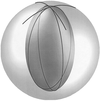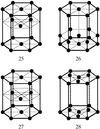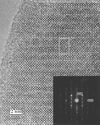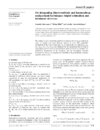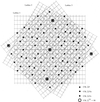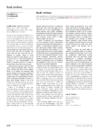issue contents
September 2001 issue

Cover illustration: Graphical representation of density modification due to third-order terms b113 = -b223 (point group ![[\bar{4}]](/a/issues/2001/05/00/teximages/fi2.gif) ) in the Gram-Charlier series expansion of a Gaussian atomic probability density function. Courtesy of W. F. Kuhs.
) in the Gram-Charlier series expansion of a Gaussian atomic probability density function. Courtesy of W. F. Kuhs.
obituaries
Free 

research papers
Closed-form analytical solution for the inversion of the integral equation relating small-angle scattering intensity distributions of two-phase systems to chord-length distributions.
The arithmetic classification of crystal structures is analyzed in the case of lattices with two or four points in their unit cells.
Statistics and diffraction by a general, finite, two-dimensional ideal paracrystal are studied in detail. Characteristics of diffraction patterns, including variation of peak widths, are examined as a function of parameters of the model.
Electron scattering amplitudes of formic acid, formic acid dimer and the formate anion were evaluated by ab initio molecular-orbital calculations in vacuo and in aqueous solution. A model of site/environment-dependent atomic scattering factors for electron crystallography is proposed.
Experimental analysis is presented showing interesting applications of the locally plane wave technique to X-ray reflectometry and to the visualization of the strain field around isolated defects.
A classification scheme is proposed for those quasiperiodic structures that can be obtained as decorations of a Gummelt covering. The classification is derived from an aperiodic tiling pattern with three tile shapes.
An electron crystallographic image-processing technique based on the combination of high-resolution electron microscopy and electron diffraction has been developed to investigate the commensurate structural modulation in the high-Tc superconductor (Pb0.5Sr0.3Cu0.2)Sr2(Ca0.6Sr0.4)Cu2Oy. In the determined projected potential map of resolution about 1.25 Å, the occupational and/or positional modulation has been clearly observed for all atoms, including oxygen.
State-of-the-art quantum-mechanical simulations of the Al2SiO5 polymorphs (kyanite, andalusite and sillimanite) predict isosymmetric phase transitions in sillimanite and pressure-induced amorphization in andalusite. Detailed structural analysis suggests the existence of critical bond lengths (e.g. 2.25 Å for Si—O bonds); the nature of the fivefold coordination of silicon, predicted at high pressures, is also discussed.
Sparsity of the normal matrix in the refinement of macromolecules at atomic and subatomic resolution
A large number of normal-matrix elements are very small in the least-squares refinement of large structures at very high resolution. The matrix sparsity is illustrated by both theory and practical examples.
The treatment of errors is integrated into the direct-methods approach of isomorphous-replacement techniques.
The structure of a decagonal Al![[_{72}]](/a/issues/2001/05/00/js0112/teximages/js0112fi1.gif) Ni
Ni![[_{20}]](/a/issues/2001/05/00/js0112/teximages/js0112fi2.gif) Co
Co![[_{8}]](/a/issues/2001/05/00/js0112/teximages/js0112fi3.gif) quasicrystal with space group P10
quasicrystal with space group P10![[_{5}]](/a/issues/2001/05/00/js0112/teximages/js0112fi4.gif) /mmc has been refined on the basis of a single-crystal X-ray data set using the five-dimensional description.
/mmc has been refined on the basis of a single-crystal X-ray data set using the five-dimensional description.
![[_{72}]](/a/issues/2001/05/00/js0112/teximages/js0112fi1.gif) Ni
Ni![[_{20}]](/a/issues/2001/05/00/js0112/teximages/js0112fi2.gif) Co
Co![[_{8}]](/a/issues/2001/05/00/js0112/teximages/js0112fi3.gif) quasicrystal with space group P10
quasicrystal with space group P10![[_{5}]](/a/issues/2001/05/00/js0112/teximages/js0112fi4.gif) /mmc has been refined on the basis of a single-crystal X-ray data set using the five-dimensional description.
/mmc has been refined on the basis of a single-crystal X-ray data set using the five-dimensional description.This paper proposes a new physical method for the partial solution of the crystallographic phase problem by illuminating the crystal with an X-ray beam of limited coherence. Under certain conditions, the total information from a continuous diffraction pattern, both at Bragg angles and at angles that do not satisfy the Bragg conditions, is sufficient to solve the crystal structure ab initio.
Line-broadening effects due to polydisperse crystalline grain systems have been included in a general expression for the intensity scattered by powder samples. In this way, the powder pattern can be simulated or modelled by using analytical expressions not relying on arbitrary profile-shape functions.
Free 

The six-field notation recommended by the Commission on Crystallographic Nomenclature [Tolédano et al. (1998>). Acta Cryst. A54, 1028–1033], for each phase formed in any sequence of structural transitions as the result of a change in temperature and/or pressure, is shown to be quite general and applicable to all transitions in the solid state. Six additional representative classes of phase transition are considered in detail, with illustrative examples provided of the nomenclature applicable to each category.
addenda and errata
Free 

book reviews
Free 



 journal menu
journal menu










